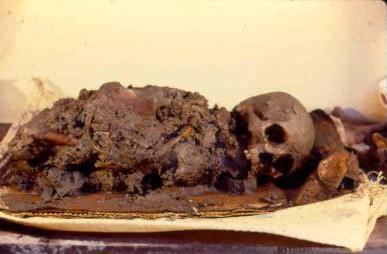Feature article: Peat wastage and wetland archaeology
Bundle Burials
Anaerobic Preservation in a Coastal Cemetery site, Nicoya Gulf, Costa Rica
by
Ricardo Vázquez L., Juan V. Guerrero M. and Federico Solano B.
Department of Anthropology and History, National Museum of Costa Rica
[ED: This article was passed to Margarita Astralaga here at the Bureau by Lic. Marco A. Solano, Coordinator of the National Wetlands Porgramme, Ministerio del Ambiente y Energía, Costa Rica. ]
|
The site is located in the southwestern shore of the gulf of Nicoya, opposite Venado Island, in an area of the tidal zone flooded most of the time. The fieldwork was carried out in 1989, 90 and 91, during the maximum lows of the major tides of each year.
The bundle burials were detected by inserting flexible metal bars through the sites dark muddy soil. Due to the short time available between the tides, the recovering procedure had to be quick. Once the presence of bones was confirmed, the bundle was isolated on a pedestal. Then, the whole block was removed from the pedestal, wrapped with bandages, and put in a cushioned box.
Thirteen bundle burials were excavated, a partial one was found lying on the surface, and two complete ones were handed over to personnel of the National Museum. In addition, a minimum of five individuals was calculated upon the scattered bones collected on the surface. As a whole, the human osteological sample of the La Regla site comprises 28 individuals. The gender ratio for those individuals more than 16 years of age at the time of death is nine females and eight males.
Of the 16 bundles analyzed, nine had single skeletons and seven contained bones of two individuals each. Within the latter group, the most common association is that of adults and subadults (five of the seven cases). Three bundles contained the remains of adult females together with remains of infants or children. Other associations included: woman/non-sexed adult, man/infants, and child/infant. Only one subadult, 10 years old at the time of death, was found buried in a single bundle.
The bones are in excellent condition, and no cut marks or scratches visible. Total degradation of soft tissue and tendons prior to the preparation of the bundles is indicated. Some of the bundles show a natural concretion of clay and calcium carbonate, which holds the bones in their original position forming a rigid block.
In three of the 16 bundles, there was preservation of the organic wrappings that held the bones. These three bundles were found between 70cm and 80cm below the surface, the largest scores in the sample. Chemical and spectrographic analyses indicate that preservation of the archaeological materials was due to the anaerobic conditions (lack of oxygen) in the deep strata of the sites mud bed. These strata remain permanently soaked with sea water and non-saline underground water from inland. On the other hand, the high content of organic matter in the mud bed uses up most of the oxygen introduced with the water. Another positive factor is the almost neutral pH of the water and mud associated with the burials.
The artifacts found with the bundles are: two carved wood sticks, 154 small wood beads, a stone metate, six pearls and a jadeite pendant. The wood of the sticks and the metate were placed in the burial pits; while the other artifacts were directly with the bundles.
One bundle is completely wrapped in strips of bark about 5cm wide. On the basis of the stereoscopic comparison, barks of three different species native to the gulf of Nicoya region were used. Two other bundles are also completely wrapped, but with ropes about 4mm wide formed by two braided strand. The fiber used to make the rope was selected and processed from either a grass or a tree bark.
As conclusions, it is possible to say the the bundles were originally buried in a coastal swamp. Otherwise, inadequate conditions for anaerobic preservation would not have existed. With time, the cemetery sank into the tidal zone due to the tilting of the Nicoya peninsula northeastern shore. The compact arrangement of the bundles suggests that they could hve been brought into the site, by land and/or sea, from relatively distant places. However, the use of barks from native trees, as well as pearls, indicates a close association of the archaeological population with the gulf of Nicoya region.
Bibliography
Guerrero, J. V., Vázquez, R. y Solano, F. 1992 "Entierros secundarios y restos orgánicos de ca. 500 a.C. preservados en un área de inundación marina, golfo de Nicoya, Costa Rica". Vículos 17 (1991): 17-54. Anthropological Journal of the National Museum of Costa Rica, San José.
